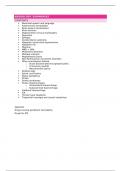Summary
Summary Neurological conditions summaries
- Course
- Institution
- Book
Summaries of all the neurological conditions as covered in Davidson’s and Oxford Clinical Handbook. Covers clinical features, key investigations, aetiology, risk factors, and management for all conditions. Have double checked all management plans with current NICE guidelines
[Show more]




